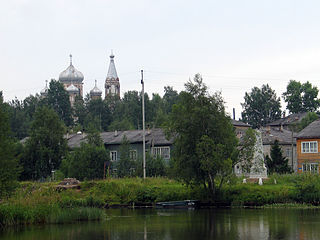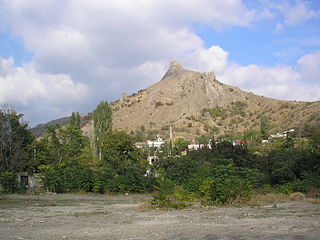
The Tatars, formerly also spelled Tartars, is an umbrella term for different Turkic ethnic groups bearing the name "Tatar" across Eastern Europe and Asia. Initially, the ethnonym Tatar possibly referred to the Tatar confederation. That confederation was eventually incorporated into the Mongol Empire when Genghis Khan unified the various steppe tribes. Historically, the term Tatars was applied to anyone originating from the vast Northern and Central Asian landmass then known as Tartary, a term which was also conflated with the Mongol Empire itself. More recently, however, the term has come to refer more narrowly to related ethnic groups who refer to themselves as Tatars or who speak languages that are commonly referred to as Tatar.

Crimea is a peninsula in Eastern Europe, on the northern coast of the Black Sea, almost entirely surrounded by the Black Sea and the smaller Sea of Azov. The Isthmus of Perekop connects the peninsula to Kherson Oblast in mainland Ukraine. To the east, the Crimean Bridge, constructed in 2018, spans the Strait of Kerch, linking the peninsula with Krasnodar Krai in Russia. The Arabat Spit, located to the northeast, is a narrow strip of land that separates the Syvash lagoons from the Sea of Azov. Across the Black Sea to the west lies Romania and to the south is Turkey. The population is 2.4 million, and the largest city is Sevastopol. The region has been under Russian occupation since 2014.

Simferopol, also known as Aqmescit, is the second-largest city on the Crimean Peninsula. The city, along with the rest of Crimea, is internationally recognised as part of Ukraine, controlled by Russia, and is considered the capital of the Autonomous Republic of Crimea.

Э э is a letter found in three Slavic languages: Russian, Belarusian, and West Polesian. It represents the vowels and, as the e in the word "editor". In other Slavic languages that use the Cyrillic script, the sounds are represented by Ye (Е е), which represents in Russian and Belarusian in initial and postvocalic position or with palatalization of the preceding consonant. This letter closely resembles and should not be confused with the older Cyrillic letter Ukrainian Ye, of which Э is a reversed version.

Ustyuzhna is a town and the administrative center of Ustyuzhensky District in Vologda Oblast, Russia, located on the Mologa River, 260 kilometers (160 mi) west of Vologda, the administrative center of the oblast. Population: 9,501 (2010 Census); 10,507 (2002 Census); 10,035 (1989 Soviet census).
The Russo-Crimean Wars were fought between the forces of the Tsardom of Russia and the Crimean Khanate during the 16th century over the region around the Volga River.

Vytegra is a town and the administrative center of Vytegorsky District in Vologda Oblast, Russia, located along the shores of the Vytegra River on Volga–Baltic Waterway, 315 kilometers (196 mi) northwest of Vologda, the administrative center of the oblast. Population: 10,488 (2010 Census); 11,400 (2002 Census); 12,905 (1989 Soviet census).

Vladimir Viktorovich Sakharov was a Russian general of the cavalry who served in the Russian Imperial Army. In his army career from 1869 to 1917, he served in the Russo-Turkish War of 1877-1878, the Russo-Japanese War, and World War I.

The Kebir Mosque is located in Simferopol, Crimea. The Kebir Mosque is a prominent architectural monument in Simferopol and the oldest building in the city.
Mikhail Pavlovich Bobyshov was a Soviet Russian painter and stage decorator, People's Artist of the Russian Federation, Honored Art worker of the Russian Federation, professor of the Repin Institute of Arts.

Kirovske or Isliam-Terek is an urban-type settlement in the Crimea, a territory recognized by a majority of countries as part of Ukraine and incorporated by Russia as the Republic of Crimea. Population: 6,883 .

The Kokkoz Jami Mosque, also known as Yusupov's Mosque, is located in the village of Sokolyne (Kökköz), Crimea. In Crimean Tatar, kökköz translates to “falcon”, just like the Ukrainian and Russian names. The mosque was built under the patronage of Prince Felix Yusupov in 1910 by a notable contemporary architect Nikolay Krasnov, the author of the imperial residence Livadia Palace.

Orta Cami Mosque is one of the oldest mosques in Crimea. It is situated on the modern day Lenina Street in the old town of Bakhchysarai.

Mizhrichchia or Mezhdurechye is a village in the Feodosia Raion of Crimea, a territory recognized by a majority of countries as part of Ukraine and annexed by Russia as the Republic of Crimea.

E with macron is a letter of the Cyrillic script.

Prince Nikolai Nikolayevich Obolensky was an Imperial Russian division commander. He was born in what is now Ulyanovsk, Ulyanovsk Oblast. He fought in wars in the Crimea, Poland and against the Ottoman Empire. He had two sons, Vladimir and Alexander.
Monument to Alexander Suvorov is a monument to a Russian Generalissimo Alexander Vasilyevich Suvorov in the city of Azov, Rostov Oblast, Russia. It was installed in 2014 on the territory of Powder Cellar Museum.

Aqmescit Friday Mosque, also known as the Great Friday Mosque and the Simferopol Cathedral Mosque named after Noman Çelebicihan is the largest mosque in Aqmescit (Simferopol), Crimea, which had been under construction since 2015 after Russian annexation of the Crimean peninsula. It opened on 9 December 2023.

Novooleksiivka is a rural settlement in the Henichesk raion of Kherson oblast, Ukraine. It belongs to the Henichesk urban hromada, one of the hromadas of Ukraine. It had a population of 10,026.
The Komi language, a Uralic language spoken in the north-eastern part of European Russia, has been written in several different alphabets. Currently, Komi writing uses letters from the Cyrillic script. There have been five distinct stages in the history of Komi writing:



















